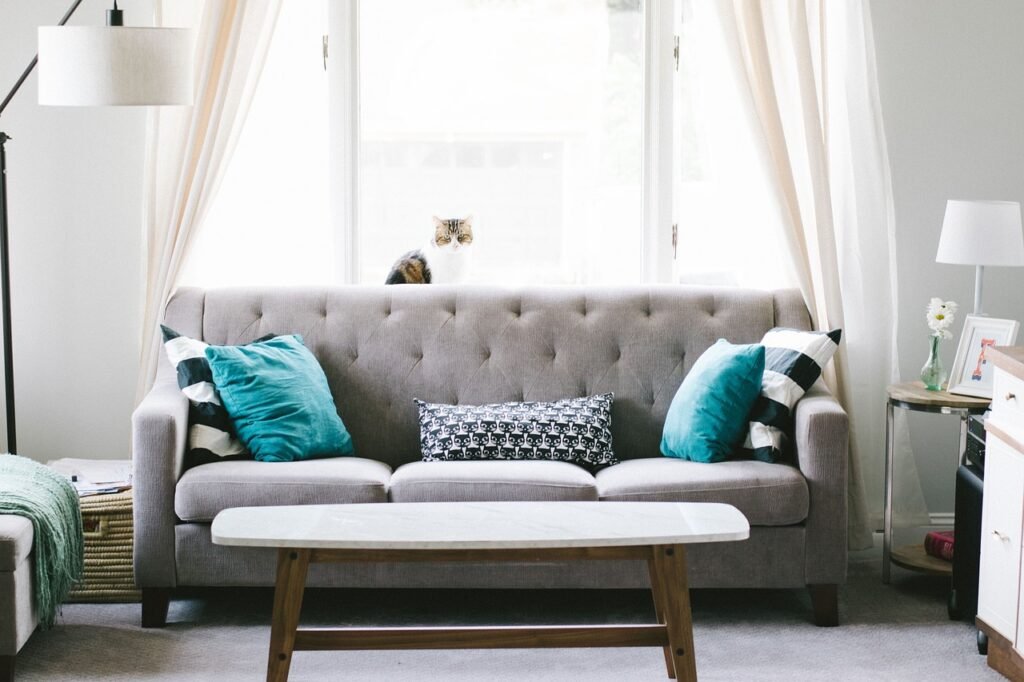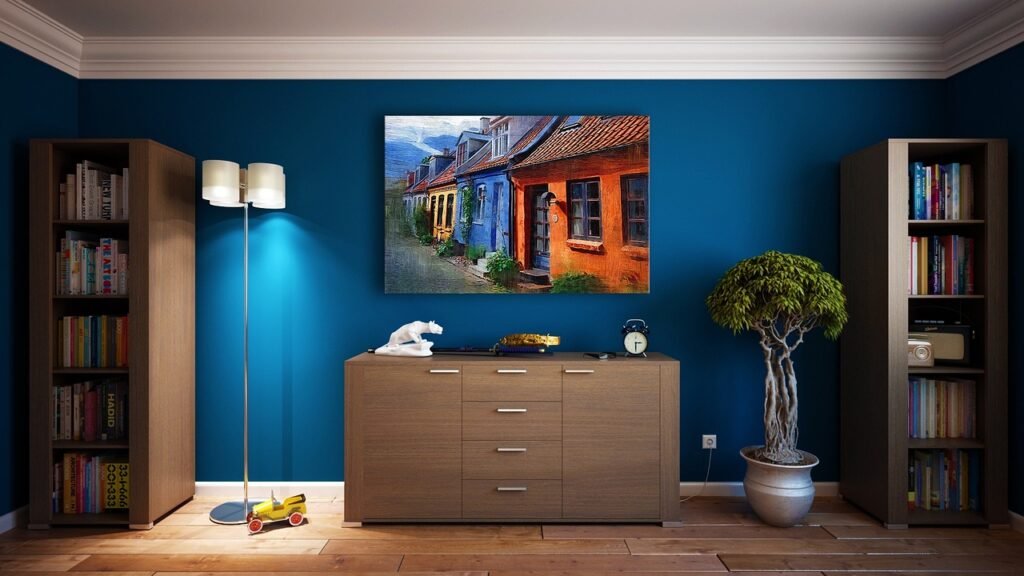Living in a small space doesn’t mean you have to settle for dim and dreary lighting. In fact, with the right strategies and a little creativity, you can optimize the lighting in your cozy abode to create a bright and inviting atmosphere. Whether you’re dealing with limited windows, low ceilings, or cramped layouts, this article will guide you through innovative tips and tricks to maximize the natural light, choose the right artificial lighting options, and create a well-lit oasis in your small living space. Say goodbye to gloomy corners and hello to a beautifully illuminated home that feels spacious and welcoming. So, let’s shed some light on optimizing lighting in small living spaces!
1. Importance of Lighting in Small Living Spaces
Enhances Space Perception
In small living spaces, proper lighting is crucial as it has the ability to enhance space perception. By strategically placing light fixtures and utilizing techniques such as up lighting, down lighting, and cross lighting, you can make your space feel larger and more open. Adequate lighting helps eliminate shadows and dark corners that can make a room feel cramped and claustrophobic. When your space is well-lit, it creates an illusion of a larger area, ultimately making you feel more comfortable and at ease.
Creates a Comfortable Environment
The right lighting can greatly contribute to creating a comfortable environment in small living spaces. By carefully selecting the color temperature of the light and using fixtures that provide a warm, soft glow, you can establish a cozy and inviting atmosphere. Warm light, typically found in incandescent bulbs, promotes relaxation and a sense of coziness. It helps to create a welcoming ambiance that makes you want to unwind and enjoy your living space. In contrast, cool light provides a more energetic and focused environment, which may be beneficial for productivity purposes.
Boosts Productivity and Mood
Proper lighting in small living spaces can significantly impact your productivity and mood. Insufficient lighting or relying solely on natural light during the day can lead to eyestrain and decreased productivity, especially during tasks that require concentration. By incorporating artificial lighting options such as task lighting, ambient lighting, and accent lighting, you can create a well-lit environment that boosts your focus and motivation. Additionally, research has shown that exposure to bright light can help regulate your circadian rhythm, ultimately improving your mood and overall well-being.
2. Natural Lighting
Maximizing Natural Light Sources
In small living spaces, maximizing the use of natural light is essential. Start by ensuring that your windows are clean and unobstructed, allowing as much sunlight as possible to enter the room. Avoid heavy curtains or blinds that block out light, and opt for sheer or light-colored window treatments that allow sunlight to filter through. Additionally, consider removing any obstacles near the windows, such as furniture or plants, that may hinder the flow of natural light into your space.
Utilizing Mirrors and Reflective Surfaces
Mirrors and reflective surfaces are excellent tools for harnessing natural light in small living spaces. Placing a mirror opposite a window can effectively double the amount of natural light in the room by reflecting it throughout the space. Additionally, incorporating reflective surfaces such as metallic furniture or glossy finishes on walls and floors can help bounce light around the room, making it feel brighter and more spacious. By strategically positioning mirrors and utilizing reflective surfaces, you can enhance the natural light in your small living space.

3. Artificial Lighting Options
Choosing the Right Lighting Fixtures
When it comes to artificial lighting in small living spaces, it’s crucial to choose the right fixtures. Opt for fixtures that don’t take up much space yet provide adequate light. Wall sconces, ceiling-mounted fixtures, and recessed lighting are great options for small spaces as they take up minimal room while still illuminating the area effectively. Consider the style, size, and scale of the fixtures to ensure they complement your space without overpowering it.
Layering Lighting
Layering lighting is a key technique in small living spaces as it allows you to customize the ambiance and functionality of the room. By combining different types of lighting, such as ambient, task, and accent lighting, you can create depth and dimension. Layered lighting not only enhances the aesthetics of your space but also provides functional lighting for various activities. For example, you can use ambient lighting for overall illumination, task lighting for specific activities, and accent lighting to highlight architectural features or decorative pieces.
Consideration of Light Bulbs
The type of light bulbs you choose for your small living space can greatly impact the quality and ambiance of the lighting. LED bulbs are energy-efficient and long-lasting, making them an excellent choice for small spaces. They come in various color temperatures, ranging from warm to cool light, allowing you to select the one that best suits your needs. Additionally, consider the brightness level of the bulbs and opt for dimmable options to have more control over the intensity of the light. Experimenting with different bulbs can help you achieve the desired lighting effects in your space.
4. Task Lighting
Zone-specific Task Lighting
Task lighting is essential in small living spaces to provide focused illumination for specific activities. Determine the different zones in your space, such as a reading nook, a workspace, or a kitchen counter, and install task lighting accordingly. Use adjustable desk lamps or wall-mounted fixtures to direct light exactly where you need it. By having dedicated task lighting in each specific area, you can minimize eye strain and maximize productivity.
Desk and Reading Lamps
For areas where you frequently engage in activities such as reading or working at a desk, desk and reading lamps are indispensable. Look for lamps that are compact in size yet provide sufficient brightness. Adjustable features such as swivel necks or adjustable arms allow you to position the light exactly where you need it. Consider the color temperature of the bulbs as well, as warmer light is often more suitable for reading and tasks that require focused attention.

5. Ambient Lighting
Installing Dimmers
Installing dimmers in small living spaces can transform the ambiance of the room by giving you control over the brightness level. Dimmers allow you to adjust the intensity of the light according to the time of day or the activity taking place in the space. Lowering the brightness in the evening creates a cozy, intimate atmosphere, while increasing it during the day provides a well-lit environment for daily tasks. Dimming your ambient lighting can greatly enhance the overall comfort and versatility of your small living space.
Using Wall Sconces
Wall sconces are a popular choice for ambient lighting in small living spaces due to their low-profile design and ability to provide a soft, diffused glow. Install wall sconces at strategic points throughout the room to create a warm and inviting atmosphere. They can serve as an alternative to overhead lighting or complement existing fixtures. With a wide range of styles and finishes available, you can find wall sconces that blend seamlessly with your space while adding a touch of elegance.
6. Accent Lighting
Highlighting Artwork or Decorative Pieces
Accent lighting plays a crucial role in showcasing artwork or decorative pieces in small living spaces. Use track lighting or adjustable spotlights to direct focused light onto the objects you want to highlight. This not only adds visual interest but also draws attention to unique features or focal points in the room. Accent lighting can create a sense of depth and dimension, making your small living space feel more curated and well-designed.
Installing Spotlights
Spotlights are an ideal choice for accent lighting in small living spaces, especially when you want to draw attention to specific areas or features. They provide a concentrated, directional beam of light, allowing you to spotlight artwork, architectural details, or other decorative elements. By installing spotlights strategically, you can create a dramatic effect and enhance the overall ambiance of your small living space.

7. Smart Lighting Solutions
Motion Sensors
Smart lighting solutions can be particularly beneficial in small living spaces by providing convenience and energy efficiency. Motion sensors are a great addition as they automatically turn on the lights when they detect movement, eliminating the need to fumble for switches in the dark. They are especially useful in areas such as hallways, closets, or entryways where hands-free control is desirable. Incorporating motion sensors into your lighting system allows for effortless illumination in your small living space.
Remote-controlled Lighting Systems
Remote-controlled lighting systems offer a high level of flexibility and convenience in small living spaces. With a single remote control, you can adjust the brightness level, color temperature, and even the positioning of your lights. This ensures that you can easily adapt the lighting to different activities or moods without the need for physical adjustments. Remote-controlled lighting systems provide an effortless way to customize the lighting in your small living space, enhancing both functionality and aesthetics.
8. Color Temperature of Light
Warm Light vs. Cool Light
The color temperature of light plays a significant role in the perception and ambiance of your small living space. Warm light, typically ranging from 2700K to 3000K, emits a cozy, inviting glow that promotes relaxation and comfort. It is often preferred in areas where you want to create a sense of warmth and intimacy, such as living rooms or bedrooms. In contrast, cool light, ranging from 3500K to 4000K, provides a brighter, more energizing ambiance that is suitable for areas where productivity is a priority, such as home offices or kitchens.
Effects on Perception and Ambience
The choice of warm or cool light can have a profound effect on the perception and ambience of your small living space. Warm light tends to make spaces feel more intimate and cozy, making them perfect for relaxation and unwinding. It can create a welcoming and intimate atmosphere, making you feel more at home. On the other hand, cool light is more conducive to productivity and focus, as it mimics natural daylight. It can make small spaces feel more vibrant, invigorating, and energetic. By carefully selecting the color temperature of your light, you can tailor the perception and ambience of your small living space to suit your needs and preferences.

9. Light Placement Techniques
Up Lighting
Up lighting is a technique that involves directing light upwards, bouncing it off walls or ceilings, to create an overall glow and increase the perceived height of the room. This technique can help make your small living space feel more spacious and airy. You can achieve up lighting by using wall-mounted fixtures, floor lamps with adjustable heads, or even hidden LED strips. By incorporating up lighting into your small living space, you can add a touch of elegance while enhancing the overall ambiance.
Down Lighting
Down lighting involves directing light downwards from the ceiling, illuminating specific areas or objects. This technique is particularly useful for creating a cozy atmosphere and highlighting certain features such as dining tables or workspaces. Pendant lights, recessed lighting, or track lighting with adjustable heads are popular choices for down lighting in small living spaces. The soft, focused light creates a warm and intimate environment, making your space feel inviting and functional.
Cross Lighting
Cross lighting is a technique that involves using multiple light sources from different angles to evenly illuminate a space. This technique can help minimize shadows and create a balanced lighting effect in your small living space. By combining overhead lighting, task lighting, and wall sconces, you can achieve cross lighting. This technique not only enhances visibility but also adds depth and dimension to your space, making it appear larger and more inviting.
10. Space-saving Lighting Solutions
Wall-mounted Lights
Wall-mounted lights are an effective space-saving lighting solution for small living spaces. By mounting lights directly onto the walls, you eliminate the need for floor or table space, freeing up valuable real estate in your room. Choose fixtures that have a low profile and sleek design, so they seamlessly blend with the overall aesthetic of your space. Wall-mounted lights can serve as both functional and decorative elements, providing illumination while adding visual interest to your small living space.
Hanging Pendant Lights
Hanging pendant lights are a stylish and versatile lighting solution that can save space in small living areas. Instead of using table or floor lamps, pendant lights hang from the ceiling, allowing you to utilize vertical space effectively. Choose pendant lights that are appropriately sized for your space, ensuring they don’t overwhelm the room. Pendant lights come in various designs, styles, and colors, allowing you to find the perfect fixture that suits your personal taste and complements your small living space.
In conclusion, lighting plays a vital role in small living spaces, enhancing the perception of space, creating a comfortable environment, and boosting productivity and mood. By maximizing natural light sources, utilizing both artificial and smart lighting options, considering the color temperature of light, and implementing effective light placement techniques, you can optimize the lighting in your small living space. Remember to choose fixtures that are suitable for the size of your space and complement the overall aesthetic. With the right lighting, you can transform your small living space into a well-lit, inviting, and functional haven.



